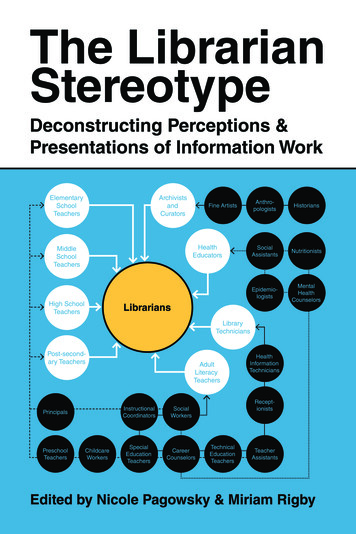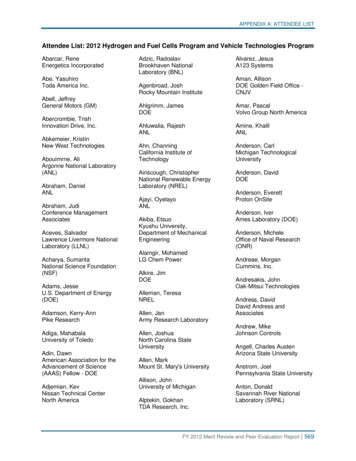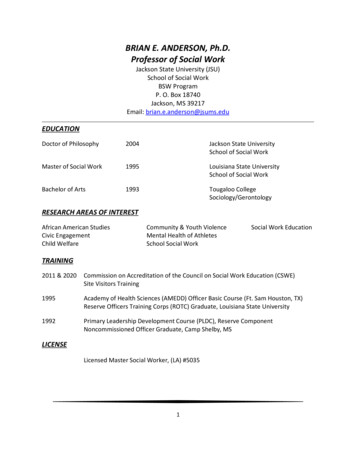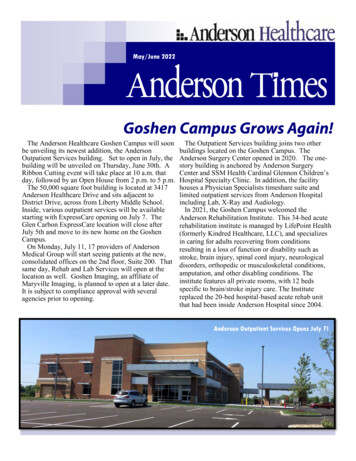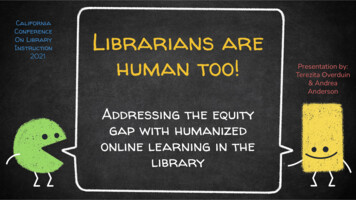
Transcription
CaliforniaConferenceOn LibraryInstruction2021Librarians arehuman too!Addressing the equitygap with humanizedonline learning in thelibraryPresentation by:Terezita Overduin& AndreaAnderson
2Who we are!Hello!Howdy Andrea AndersonTerezita Overduinshe/her/hersChaffey CollegeReference LibrarianRock Climber she/her/hersCSU, BakersfieldInstruction & ReferenceLibrarianSwimmer #CCLI2021#HumanizeLibrarians
3What we are doing today A look at the literature: Why humanize?CSUB and Chaffey College: Differentapproaches to instructionBreak out rooms: How do you humanize?What we did: Synchronous vsasynchronousMake your own video!
1.Humanizing virtualInstructionWhat’s the Literature say?
5Online achievement gap between Latinxstudents and white studentsIncreases 44%Compared to traditional classesKaupp, R. (2012) Online Penalty: The Impact of Online Instruction on the Latino-White Achievement Gap. Journal ofApplied Research in the Community College, v19 n2 p8-16
6Public Policy Institute of California. (2014). Online learning and student outcomes in California's community collegesPalacios, A. M., & Wood, J. L. (2016). Is online learning the silver bullet for men of color? An institutional-levelanalysis of the California community college system.
7Student-instructor relationships“He was veryavailable . . . eventhrough email, hewould respond to youas soon as he could.”“We don’t really havea relationship. It’s like,do your work, and so Ido my work, and thatis about it.”“It’s very much aboutcoursework and that isthat. She doesn’t careabout what is going onin my life.”Kaupp, R. (2012) Online Penalty: The Impact of Online Instruction on the Latino-White Achievement Gap. Journal of Applied Research in the Community College, v19 n2 p8-16
Student-Instructor relationships Interpersonal interaction is the BIGGEST predictor of student gradesStudents in courses with lower interaction earned nearly ONE GRADE LOWER thanstudent in courses with high interaction8
9Michelle Pacansky-Brock on Humanization“Humanizing is a pedagogical strategy that seeks toimprove equity gaps by acknowledging the fact thatlearning environments are not neutral; rather, they oftenoperate to reinforce a worldview that minoritizes somestudents.”“Humanizing removes the affective and cognitivebarriers from online learning, and provides a pathwaytowards a more equitable future for higher educationthat supports the success of all students.”
Michelle Pacansky-Brock on HumanizationPrinciplesPedagogy “Relationships beforepedagogy”Humanize intentionallyResearch showsstudents more likely toapply themselves whenthey know instructorsbelieve in them. TrustPresenceAwarenessEmpathyPacansky-Brock, M. (2020). How to humanize your online class, version 2.0 [Infographic]. https://brocansky.com/humanizing/infographic210
11Applying Pacansky-Brock to the Library TrustShare yourself! Show your similarities, a story, a challenge. PresenceBe authentic, put your own style/humor/personality in your voice,record videos authentically AwarenessLearn who your students are, what they struggle with EmpathyListen, look at the class through their eyes, be willing toadapt, be available,
12Instruction at our institutionsChaffey CollegeCal State, Bakersfield University (undergrad, grad,doctoral students)Primarily synchronous7 Library coursesGeneric info lit tutorialand anonymouslynarrated videos Community college(2-year)PrimarilyasynchronousNo library courses;one-shots onlyGeneric videos andtutorials
2.Break out Room!Meet your fellow participants!
14Questions to discuss1. Show you’re human!Introduce yourself, and share how yourquarantine was unique!2. Share your experienceLibrarian created videos and instructional contentsometimes leave out the librarian. How do youconvey tone/nuance to your students? How do youconnect with them on a social/emotional level?BreakoutRoomQuestions!
3.Here’s what we didSynchronous vs asynchronous,one-shots, credit bearingcourses
16Humanizing your course Creating a variety of videos Empathetic class policies encouragelearners Detailed, student specific Feedback
17Video enhances the learning experience“Video can enhancethe teacher’spresence whenhumour, wit, andpersonable contextare applied to theonline course subjectmatter”*Week 7Evaluating Information!*Kilgore, W. (2016). Using video to humanize online instruction. Humanizing Online Teaching and Learning.
18Mixing video into my courseWelcome videoAnnouncementsGives students a sense of who you are right away! .
19Flexible Late policy
20Humanize with Feedback!
21“Sometimes online classescan lack or feel one sided,and the instructor madethis course feel theopposite.Humanize withFeedback
22The One-shot zoomMake it count! Keep your camera on Use discussion posts toget to know students Share a personal storyin your introduction Use their names Breakout Rooms
23“She was very positive and energetic about the course.”“I enjoyed interacting “She is kind, helpful, andattentive to emails.”with the other students instructor, even with“She took interest in me when Ithe course beingwas struggling.”online.”“Very helpful, and caring.”“She is very helpful and, although we never met faceto face, seems like a wonderful person who caresabout students' learning outcomes.”Student can see when you make an effort!
24Chaffey College
25The asynchronous one-shotChunkingConnectionBreak up contentinto smaller,more digestibleparts withopportunity forstudents topause and reflectHow do studentsget to know you?How do theysense that theycan trust you tohelp them?45 Minutevideo
26Re-designing content Embedded my profile in Canvas course Publish discussion forum Introduction focused on humanizing mypresence Link to full guide/library module
27Link to Guide
28“ReferenceInteractions
2940003000200010000Terezita’s email & Zoom reference questions: 310% increaseAll library reference questions: 20.9 % increase
30Survey says.8 respondents1 respondent
31Survey says.7 respondents1 respondent1 respondent
Survey says.“I loved these videos. Watching Teresita talk about the process of using thedatabase and Chaffey's online library helped me so much. Now I have an idea ofhow to find credible scholarly sources.”“I enjoyed the videos, it provided useful information as well as getting to know alittle bit about Terezita.”“I liked how you kept the videos at a reasonable length, and there wasn't toomuch fluff. I have a better idea of who you are (and your subsequent services)after the videos. Since they weren't too long, I feel they were more efficaciousthan huge text chunks.”32
33A reference story
4.Your turn!Get your phones/tablets out- you’re goingto make your own welcome video!
35Humanize librariansThe hardest part is getting over the fear of seeing yourown face and hearing your own voice on a video! Use your phone/tablet/any extra device near youPoint it at your own faceRECORD! Imagine a struggling student is asking you, “Sowho are you and how can you help me with my studies?”Imperfection is keyShare your video with us #CCLI2021 #HumanizeLibrarians
36#CCLI2021#HumanizeLibrariansThanks!Any ontact us at:aanderson17@csub.edu@WWStiernLibrary
5.Extra ResourcesUtilize the following links for ideas onhumanizing your own virtual classroom
ResourcesHow to Humanize your Online Class InfographicHumanizing the Online Experience TutorialHumanizing your online instruction: The COVID-19 versionProfessors Share Ideas for Building Community in Online Courses38
ReferencesIce, P., Curtis, R., Phillips, P., & Wells, J. (2007). Using asynchronous audio feedback to enhance teaching presence and students' senseof community. Journal of Asynchronous Learning Networks, 11, 3-25. http://dx.doi.org/10.24059/olj.v11i2.1724Jaggars, S., & Xu, D. (2013). Predicting online student outcomes from a measure of course quality (Working paper no. 57). CommunityCollege Research Center. Jaggars, S. S., Edgecombe, N., & Stacey, G. W. (2013). What We Know about Online Course Outcomes. Research Overview.Community College Research Center, Columbia ner-Packet.pdfKaupp, R. (2012) Online Penalty: The Impact of Online Instruction on the Latino-White Achievement Gap. Journal of Applied Research inthe Community College, v19 n2 p8-16.Pacansky-Brock, M., Smedshammer, M., & Vincent-Layton, K. (2020). Humanizing Online Teaching to Equitize Higher Education. CurrentIssues in Education, 21(2).Palacios, A. M., & Wood, J. L. (2016). Is online learning the silver bullet for men of color? An institutional-level analysis of the Californiacommunity college system. Community College Journal of Research and Practice, 40(8), 89339
40Q&ALet us know your thoughts and questions!
41CreditsSpecial thanks to all the people who madeand released these awesome resources forfree: Presentation template by SlidesCarnival Photographs by Unsplash
Chaffey College Community college (2-year) Primarily asynchronous No library courses; one-shots only Generic videos and tutorials 12. 2. Break out Room! Meet your fellow participants! 1. Show you're human! . database and Chaffey's online library helped me so much. Now I have an idea of

